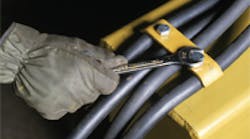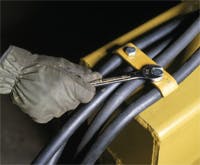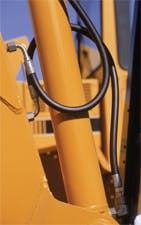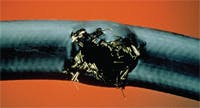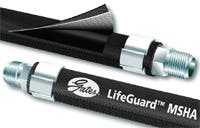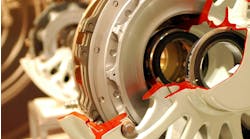Increase hose life and safety with proper protection
“An ounce of prevention is worth a pound of cure.” It certainly applies to protecting hydraulic hoses on plant machinery and mobile equipment. Higher pressure systems and more compact machine designs are challenging both original equipment engineers and operations managers to find ways not only to extend the life of hydraulic assemblies, but also to protect operators from catastrophic hose failures resulting from bursts or pinhole leaks.
Whether designing original equipment systems or replacing hydraulic assemblies in the field, consider three basic principles for both longer hose life and greater operator safety:
• proper routing,
• cover materials, and
• guards and sleeves.
Follow proper routing procedures
First and foremost, the best way to protect a hose assembly, especially from abrasive wear that can lead to leaks or failure, is to reroute it away from hose-to-hose and hose-to-metal contact. To prevent potential hazards and ensure productivity of the equipment, follow these basic hose routing tips:
Avoid Heat — Don’t position hose next to heat sources. Heat from external sources, such as exhaust components on mobile equipment, can quickly damage the hose wall from the outside in. Therefore, keep hose away from external sources of heat. If this is not possible, use insulated protective sleeving to partially block heat transmitted to the hose. Also monitor internal heat. Pumping hydraulic fluid at temperatures above the maximum operating temperature can cause cracking and cut expected hose significantly. Always select a hose that meets the temperature and flow requirements of the application. Avoid using an undersized hose, which is also a source of overheating.
Keep hose away from other materials — Don’t position hose next to metal edges or too close to other hoses. Continuous rubbing against equipment components, other hoses, or objects in the operating environment can result in the hose cover wearing away, exposing the reinforcement. Exposed reinforcement is susceptible to rust and accelerated damage leading to failure. Prevent abrasion by bundling together hoses that flex in the same direction. Clamps, bent-tube couplings, nylon ties, spring guards, and sleeving can be used to keep hose away from abrasive sources. High- and medium-abrasion resistant covers as well as protective sleeving can also be used to protect hose covers from abrasion.
In addition, it is important to avoid straining hose. Use elbows and adapters to relieve strain on the assembly and to provide neat installations accessible for inspection and maintenance. They can be used in the following situations:
• To avoid fitting orientation. Do not use an angle fitting on both ends of a hose assembly. Use a straight fitting and an angle adapter on the other end. This method makes installation easier and eliminates the need for orientation of the end fittings.
• To change size when jump-size fittings are not available. Make the jump with an adapter.
• To ease port connection and hose installation.
• To change to a different thread configuration.
Avoid exceeding the minimum bend radius. Bending hose tighter than recommended places excessive stress on the reinforcement, severely reducing the hose’s ability to withstand pressure. The result could be a burst hose or a pinhole leak. Reroute hose to eliminate excessive flexing and to meet minimum recommended bend radius. Refer to hose specification tables for minimum bend radius requirements.
Allow for length changes when the hose is pressurized. Hydraulic hose can elongate up to 2% or contract up to 4% during pressure cycles, depending on construction. Take this into account when routing hose. Excessive lengths can contribute to pressure drop, heat build-up, and potential damage from external obstructions. Insufficient lengths can strain reinforcement wires, pull at couplings and reduce service life.
Don’t mix and match. Safe, long-lasting hydraulic assemblies begin by choosing the right components — hoses, couplings, and crimpers — that are designed to work together as a system. Major manufacturers offer safe, high-quality components that are built to conform to SAE (Society of Automotive Engineers) specifications. However, the SAE hydraulic hose, coupling, and adapter standards are limited to performance and construction. As a result, hoses, couplings, and adapters from various manufacturers may be built to comparable standards (SAE), but use different rubber compounds, metals, general materials, and crimp specifications. Consequently, mixing and matching couplings from one manufacturer with hoses from another manufacturer can lead to premature assembly failure and is not recommended by any major hose and coupling manufacturer or by SAE. An improperly coupled hose will likely fail (blow-off or leak), causing downtime and possible personal injury. It is also critical that the components be assembled with the hose and coupling manufacturer’s crimping equipment and procedures.
Consider mechanical movement when bundling. Never bundle high-pressure with low-pressure hose, or rubber with thermoplastic or Teflon hose. Under pressure they can work against each other. Bundles, like individual hoses, should only bend in one plane.
Route high-pressure hydraulic lines parallel to machine contours whenever possible. This practice helps save money by reducing line lengths and minimizes the number of hard angle, flow-restricting bends. This kind of routing protects lines from external damage and promotes easier servicing.
Use adapters to make installation and orientation easier. Adapters are used to ease port connections and hose installation, or to change to a different thread configuration. A straight adapter and bent-tube coupling are typically a better choice than an angled adapter and straight hose end if cost is an issue. Adjustable adapters can leak over time, so take both cost and performance into account when deciding on the hose assembly/adapter configuration.
Prevent failure with abrasion-resistant cover materials
A primary source of hydraulic hose failure is cover abrasion resulting from cuts, friction caused by other moving parts, or from mechanical impacts. For example, changes in fluid pressure can cause hoses to either elongate or contract, repeatedly impacting adjacent machine elements or other hoses, eventually wearing away the hose cover to expose the underlying reinforcement. Erosion of the cover material can also be caused by non-compatible fluids such as toxic chemicals, acids, detergents, and non-compatible hydraulic fluids.
Major manufacturers have developed upgraded cover stocks to resist abrasion, environmental degradation, and excessive heat. Made of special rubber/plastic compounds, these new hybrid cover materials have a slick surface with a low coefficient of friction. They have been tested to last up to 300 times longer than traditional hose cover materials, such as Neoprene and Nitrile. This feature increases service life, lowers maintenance, and eliminates the need for hose protectors such as guards, sleeves, and bundling.
Protect with guards and sleeves
To further protect hydraulic hoses from external damage and wear, design engineers and operations managers can use several different types of hose guards or sleeves:
Metal Spring Guard — This form of hose protection is often used when an exposed hose may encounter flexing, twisting, kinking, tensile or side loads, a tight-bend radius, and/or vibrations. The metal spring guard needs to be fitted before the hose is assembled.
Plastic Spring Guard — This flat, plastic guard is also used on exposed hoses, but has the added advantage of being able to be fitted after the hose has been assembled and sometimes after it has been attached to the equipment.
Textile/Nylon Sleeving — This type of sleeving is often used on hoses inside the equipment or in places where abrasion may occur. The textile sleeving offers excellent wear resistance and can help reduce the amount of oil spillage.
Although these sleeve covers may protect a hydraulic hose from abrasion and cuts, they typically offer little or no protection from hose bursts and pinhole leaks that can compromise operator safety.
A pinhole leak in a hydraulic hose that is under pressure can release toxic fluid at more than 600 ft/sec — close to the muzzle velocity of a gun. The very fine jet of hydraulic fluid at high pressure will act like a hypodermic needle that may penetrate both protective clothing and skin.
To protect operators of hydraulic equipment from catastrophic hydraulic hose bursts or pinhole leaks, several hose manufacturers have developed their own versions of a safe “line-of-sight” nylon sleeving.
Dennis Kemper is Team Leader, Worldwide Product Application for Gates Corp. Contact him at (303) 744-4391, [email protected], or visit www.gates.com/hydraulics.
ISO 3457 and EN474-1 state, “Hydraulic hoses containing fluid with a pressure of more than 5MPa (50 bar) and/or having a temperature over 50°C, and which are located within 1.0 m of the operator, shall be guarded.”
Mining industry equipment must conform to Mine Safety and Health Administration (MSHA) standards and be certified. MSHA’s Accident Prevention Program simply says, “Install abrasion protection such as spiral wrapping, sleeves and guards.”
ISO and European standards don’t specify a test method for sleeving products.
Although no current industry regulations exist, Gates Corp. has developed its LifeGuard sleeve following a rigorous testing program that could likely be used to establish future standards for end-user applications. The LifeGuard sleeve has been tested both in the lab and in the field to verify its performance and capabilities at typical fluid pressure and temperature levels.
Gates’ LifeGuard sleeve is comprised of two nylon layers. During manufacture, the two sleeve layers are continuously woven at the same time, one inside the other, but they are not attached to one another.
The inside sleeve layer is made of nylon fiber that elongates or stretches up to 20%. By stretching, it can absorb the energy of a burst or pinhole leak. The outer sleeve contains the fluid and redirects it to the clamped ends. The outer sleeve is resistant to abrasion, but is not specifically designed for abrasive environments. Worker safety within a three-foot line-of-sight of a burst or pinhole leak is the primary benefit.
The sleeve is secured at either end of the hose with special “channel” clamps. The clamps allow leaking fluid to escape, so the fluid won’t collect behind the sleeve and cause it to rupture. Fluid leaking past the clamps lets the operator know that there’s a leak in the hose.
LifeGuard sleeving protects hoses from 3000 psi pinhole leaks and 6000 psi bursts on –4 (1/4 in.), –6 (3/8 in.) and –8 (1/2 in.) hose sizes. The sleeving is compatible with a wide range of fluids, including environmentally friendly liquids and biodiesel fuel. It protects up to 212° F, the SAE standard for most industrial hydraulic applications. The line-of-sight sleeving is a safe, effective, economical alternative to other costly metal, plastic, and nylon shielding.
For more information on LifeGuard line-of-sight sleeving and other Gates hydraulic products, visit www.gates.com/lifeguard.
